
Ornamental Jewels & Essential Jewellery wear – Is it only for decorative purpose ? Does any women need it really? What are Significance of wearing ornaments of Jewel for woman in Particular? What if they don’t wear it? The modern trend is reversing and people are on the look for rationale meaning to the ancient custom and traditions of Hindu, Indian and Vedic Era! Here is the answer to many unanswered questions; this article is just simply explaining the Indian & Hindu women’s favorite Jewels and ornaments right from Vedic days up till today. Wow! A total number of 36 kinds or Ornamental jewellery were used during then; but now most of the jewellery names are not even known to many of the younger generation. Just to remind them of the past life styles and fashions, I list below a few of the jewellery and ornaments that were used in those olden days and it’s scientific value in practical terms. Yester years’ women’s favourite ornaments are listed with its usage and explained with its significance of wearing the same.
TRS Iyengar

Ornaments and Jewels are considered fashionable all over the globe. But in ancient times, Indians & majority of Hindu women used these ornaments, mainly made of Gold and some Silver, with so beautiful crafting and designs, all the good work of handcrafted by goldsmiths. There were and are numerous ornament decorative or otherwise but the Hindus wore these ornaments in every visible part of their body! They wore jewellery items not just for show, but with some inner meaning to it. Here I am giving the ornaments worn usually by any Indian Women.
Normally, Women are very of fond of wearing all sorts of ornaments made from gold and Silver. More so Indian women. It is said that more than 40% of the gold products in the world is bought by Indians! But they used only silver ornaments below hip level. Each and every ornaments they used, were somehow connected with human anatomy and functions. Only a person who knows anatomy fully can describe the functions in a systematic way. However, I am giving here the reasons and value for wearing each and every ornament on the body that you will find most Hindus are possessing with them.
To begin with, an Item used as Metti by Indian married women in general and Brahman women in particular, is made of Silver. This is a ring with two or three line rounds, worn in their second finger from toe. By wearing this in both feet, it is believed, that their Menstrual cycle course is regularized with even intervals. This gives good scope for conceiving to married women. Also it is said just because that particular nerve in the second finger from toe, also connects the uteruses and passes thru heart. Because of this, the constant friction caused while walking and doing all sorts of chores during a day, it revitalizes the productivity organs. Silver being a good conductor, it also absorbs the energy from the polar energies from the earth and passes it to the body, thus refreshing whole body system.
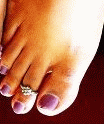
This ornaments only used by married women, just to set regular cycle of menstrual course for them to conceive. Wherein no unmarried women should conceive, even by accidental contacts. So unmarried women not allowed to wear this ornament. Also, when one becomes widow, they remove it. The reason is clear and one can understand its meaning.
Next, above their feet joint, they used to wear an ornament known as kolusu in Tamil, Ghungru in Hindi, which is known as Anklets in English. It is widely believed that by wearing this, one’s energy is not wasted but re-vibrated back to one’s own body. How far this is true just cannot be said, but for generations Indian women of all ages and walks wear this ornament, even today. This item made of Silver and is available in so many attractive designs and it really makes a women pretty good in looks!
Then an ornamental jewellery called Kaappu, is also a type of Anklet made of silver is given to children from the 11th day they are born. For this they have a separate function called naming ceremony commonly known as Naamakaranam. Sometimes this Anklet is made with Silver and Copper mix.
Another jewellery ornament knowingly used by Indian women as Hip Belt called Oddiyaanam. This too, is made of Silver, but the usage of this is not common. It is very particularly used to control women from getting fatter and to avoid flabs in hip and pot belly. Since no women uses these days this ornament, one can see the results that is visible!.
From the body level, all sorts of Gold ornament is used. Each part of human body is divided into two parts – Upper and lower level. In the lower part (i.e. below naval) they used all silver made items, wherein in the upper portion they used Gold made ornaments. Chain, Necklace, Pendants are used with decorative passions, stones and designs. Every married women used to get a Mangalsutra, which is known as Thali in Tamil and Thirumangalyam amongst srivaishnavas. This is mostly made in gold as an identifiable mark for married women. This too is believed to regularize a women’s blood circulation. This is also said to control the body pressure levels to a maximum extent, as Indian women tend to work hard, more than her male counterpart. The most important thing to note about this Thirumangalyam is, that it should always be hidden or covered in the inner garments. Just because of the constant friction of the metal gold touching the body portion directly, the effect will be more to gain the said benefits. However, if the same is worn outside the clothes and making it visible to everyone, then the effect is reduced. That’s why it is always advisable to wea the Thirumangalyam known as Thali or Mangalsutra inside the blowse and not to show off.
Following Images are provided by Mr. Srinivas Rao of Aabharana Jewellers, Matunga.
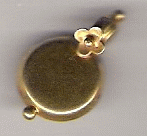
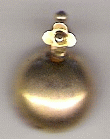
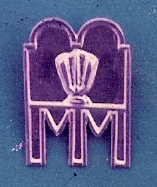 |  | 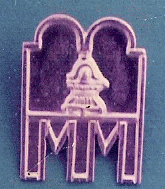 | 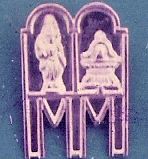 |
In the Hindu culture & tradition, and for every married women, the mangalsutra holds an important place, especially with the wedded women of that religion. Hindu women hold the mangalsutra, to be a very significant bond with their husband; it is just similar to the wedding rings in western countries. It is removed from their neck only one becomes widow. In the modern times, most of the working class women discard this one for many reasons, one for being fear of snatched during train journeys. A few, as a fashion never wear any ornament, despite their marital status which demands wearing one for ever.



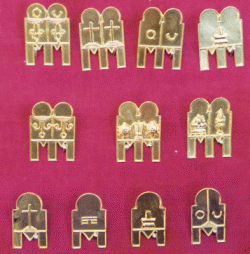
The following images shows different types of South Indian Thirumangalyam known as Thali in Tamil & Telugu and Mangal Sutra in Hindi.
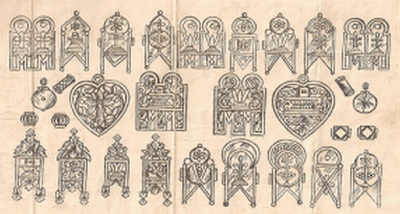
(I am thankful to my friend Mr. M. R Srinivasan, Kalva for providing the above images.)






In the Eastern India, specifically from Bengal, they used to wear a bangle made out of Ivory to show the marital status. Married women wears the Ivory Bangles in West Bengal but for them the mangalsutra is not of much any significance.
Now let us see the next item – Ear Stead. This ornament is mostly made of Gold with innumerable designs and fashions. Some in Gold with stones and some with plain Gold designs. This is considered to be the most important ornament and from childhood days Hindu girls are given this ornament. The boys too wear it from the age of 7 years. Though ear piercing takes place on completion on one full year, they wear these stead only after completion of six full years. The reasons for wearing these stead are clearly given in my article on the other page under “Yagnjopaveetham – Poonal” . You will find it in the article’s 9th paragraph explaining the reasons in detail.
If one is agreeing with these contents or not, in general everyone is aware of the fact, that these ornaments were and are being used by most of the Indian women. But one must be aware that our olden fashion and style of yesteryears did not die despite changing scenario. As a matter of fact, the interest in wearing all sorts of ornaments are in the increase, one can judge from sale of Gold in the Indian Markets. For some it is a display of wealth. For many it is really an investment mode. For a few it is compulsion of social status. And for many it is a distant Dream.
Now, this discussion is only on the value one gets by wearing such ornamental jewellery. So let us see the next precious item called Bangles. Normally the wrist portion is in constant activation on any human. Also the pulse beat in this portion is mostly checked for all sort of ailments. Even though, pulse beat is counted from the wrist, the heart beat ratio too, is taken for checking one’s health conditions. The Bangles used by women are normally in the wrist part of ones hand and its constant friction increases the blood circulation level. Or so it is believed. Further more the electricity passing out through outer skin is again reverted to one’s own body because of the ring shaped bangles, which has no ends to pass the energy outside but to send it back to the body. This way a women gains her strength which is presumably wasted otherwise. So the ancient Hindus gave shape to this item called Bangles and later it got molded in to many shapes and designs to add more attraction and beautification. Amongst other varieties of ornaments Bangle is most important for any women, it is felt and that too if it is made of Gold then only it gives you the aforesaid values & meaning.
The next item is a piece of stead-like ornament worn by women in their nose, commonly known as nose-ring and nose stead. (known as Mukkuthi or Mookuthi in Tamil and Nath in Hindi – please do not miss this article, this full page is devoted to explain about the benefits of Nose Ring/Nath) The custom to wear this ornamental jewel is typically different from one state to other, one caste to other and even different amongst communities. Some use it in their left nose, some at right and few wear it in both sides of their nose. Though it is mainly used for beautifying women, the in-depth meaning can’t be termed as unfound myth. It is considered as a breath regularizing and some say it is just to eliminate the poison coming out while exhaling carbon. Because the practice varies from one part to another, one cannot be sure what the actual benefit derived is, by using this item. But traditions apart, every community and caste, without any barrier uses this nose-stead. No one can deny, that this ornament adds extra beauty to the wearer!
Now, for the finger rings! In every part of the globe, this ring is mainly used during betrothal and marriages, thus signifying that the person, is a married person. The ring finger is most appropriately used to wear this ring. In ancient India, they classified the significance of each finger that controls or is in anyway connected to each part of one’s body and the brain. To keep this point elaborative one has to go in for details.
The Thumb in both hands are believed to be connected to the brain neurons/nerves which connects the sexual organs. And this finger is identified with planet Venus, The Goddess of Love. Any metallic friction in the body kindles specific brain neurons. So as to avoid frequent frictions in a specific part, they avoided wearing any ornaments in the Thumbs. The meaning is well understood!
According to Palmistry, the second finger from Thumb called the index finger, is identified with planet Jupiter. This finger’s nerves are connected to the brain, in its learning capacitor neurons. If in one’s horoscope Jupiter is ill placed then astrologers advise the person to wear gold ring in index finger, preferably with Yellow Sapphire stone, which again identifies the Planet of Jupiter.
Then the Middle finger. It is said that it’s nerve is passing through the brain divider line and if any metallic friction is here, then the confusion is caused in the brain whether the signal given is from left or right side of the brain. When some important decision is to be taken and if the confusion prevails because of wearing a ring in the middle finger, then it is likely to be the wrong decision. To avoid this, generally people never wore nor wear any rings in this middle finger. However, there are some exceptions given, according to Astrology and Palmistry, under which a person can wear a ring with Stone of Blue Sapphire (and in some cases Coral). In palmistry, this finger is identified with planet Saturn.
The most vital is its function and connectivity, the fourth finger from the Thumb, known as the ring finger is identified with the Star-Sun. It is widely believed, that the nerve passing through this finger is evenly spread to the entire brain neuron cells and any frequent metallic friction caused in this finger is very good for one’s health. It also improves one’s general capacity in handling his/her life with ease and confidence. That’s why all over the world, they use gold rings for men and women, very commonly in this finger. Specifically during engagements and marriages. It also signifies one’s marital status just at a look. I sincerely suggest every one to wear a gold ring in this finger so that he/she prospers through out their life.
Finally, the little finger. This finger is identified with planet Mercury which controls the organs that is ruling the brain, thoughts and thinking. Any friction in this finger causes some disturbance in one’s thoughts. So only when the planet Mercury is weak in a natives horoscope, then they wear any ring in this finger with an Emerald stone.
For Mars and Moon too, in addition to above, they identify the middle and the little fingers respectively.
Each caste or community had its typical ornament. In the southern part of India, all the four States viz. Andhra Pradsesh, Karnataka, Kerala and Tamilnadu has an unique and typical way of using golden ornaments. While most of the Adivasi tribal and backward classes used Silver made ornamental jewelry, the most forward and Brahmin community used gold made jewelry as a display of wealth. It also makes one feel secure as an investment that can be encashed anytime they wish!
In Kerala, the Nair community women use an ornament known as Nagapadam or serpent hood, just as this resembled the serpent, in pendant shape. An ear ornament called Toda or Thodu, a double convex disc, is used after dilating the earlobes. Mukkuthi was an ornament for nose and Kappu for the wrist. The famous ornaments for the neck were Addyal, (addigai in Tamil), Yantram, Avil Mala and Puli Nakham (Tiger’s Nail!). Cherutali is a kind of necklace worn loose over the breast by Namboodiri Brahmin women, while women from Tamil Brahmin community used Kasu Mala and Oddiyanam.
Even Christian women used to wear a kind of heavy guilt brass ring called Mekka Motiram, after piercing their ears in several places. Ottezhapathakkam (Single line Medal shaped), Kombu, Tala etc., were also typical Christian ornaments. Though most of the traditional ornaments stated here have become defunct now, in Tamilnadu & Kerala, still women are fond of typical ornaments, and jewelry items that are shaped and crafted with modern designs and craftsmanship. One most common among all the south Indian married women are an ornament named “Thali” known as Mangalsutra in Northern part of India and Thirumangalyam to the Sri Vaishnavites.
There were more than 48 kinds of essential jewel, jewelry & fashion ornaments used during Vedic era, each signifying body mechanism. Though the rich, affordable and King’s family had it all, even the poorer of poorest did wear most common items from the above lists. The names of which are not common and most of these jewels & ornaments are not in common use these days. However most commonly used Jewelry ornaments and its usage is given in this article. More so, the astrological point of view ought to be taken while suggesting an ornament, if it is to be fixed with some Gem and stone.
Few of the Tamil names which are common and known to many are listed below:
Metti (used in the second finger from toe)
Kolusu (Anklets made in silver with verities of shape and design)
Kappu (Plain anklets)
Oddiyanam (a belt type jewel used to tighten the sari, in the hip)
Haram ( Necklace)
Malai (Made of Pearls & Corals)
Sangili (Chain made of gold only)
Valayal (Bangles)
Kaikappu (Bangles without designs) known as Kappu
Neli (Finger ring), Mothiram
Thodu (Ear Stead & rings)
Olai (Ear steads with larger make)
Sutti (Used in the forehead)
Rakkadi (used in the backhead, hair design, to hold the bunch of lengthy soft hair spun and tied)
Kanganam (armband)
Mookuthi (Nose stead) (Mukkuthi)
The following are the names of some more jewel items which were used by Tamil Brahmin women in particular and Hindu women in general, those days; but most of the jewelry items are not in use today or rarely used ornaments at occasional functions.
Kaarai
Vangi
Addigai (Belt strap ornament)
Kattuvanam
Kaasi Malai (made of coin shaped necklace)
Jadanagam (used to tie the hair band from back side)
Nagothu
Tholvalai Kappu (used in the shoulder to hold the sari)
Batti
Besari (A stead in gold with stone studded Nose stud or ear stead with a hanging design)
Nagar or Nagam (A cobra shaped ornament used the upper arms)
Surya & Chandra Pirai (Sun & Moon shaped ornamental jewel used to decorate their forehead)
Bullakku (A designer jewel worn in the that hangs from the nose stead or ear stead)
Thandai (a jewel made of Silver worn in the ankle with some precious stone studded from inside of the jewel, like a pipe-shape ring that weights heavy)
Salangai (A jewel made in silver with a series of small silver bells and worn in the anklet – Mostly used by classical & Bharathanatyam dancers)
Maattal (A chain shaped jewel used to hook in the hair from the ear ring stead or nose stead)
Lolakku – A designer jewel that hung from the ear stead.
Jimikki – A designer jewel that hung from the ear stead.
Bullakku – A designer jewel that hung from the nose stead.
Gajjal
Aranaal (a silver made item, a chain shaped one used along with inner side of sari at hip level)
Kodi Malai – A chain made in the shape of leaves and plants of soft designs in plain gold.
Silambu – A ring shaped jewel in a pipe mode within the pipe they used to contain precious Pearl, silver balls, coral beeds etc.( Oh, a history was created by Kannaki, using the Silambu with Pearl Beeds; Kannaki burnt the town Madurai with her inimical power to prove her husband is innocent. A chapter dealing with Silambu is known as Silappathikaram in Tamil!)
I conclude this for now and leave it to the reader to judge the values of jewelry worn for ornamental values and decide which one is the best that suits him/her. If you know the name/names of any more jewel worn by the olden days, please mail me the names and its usage for me to publish here in these pages.

Leave a Comment
You must be logged in to post a comment.